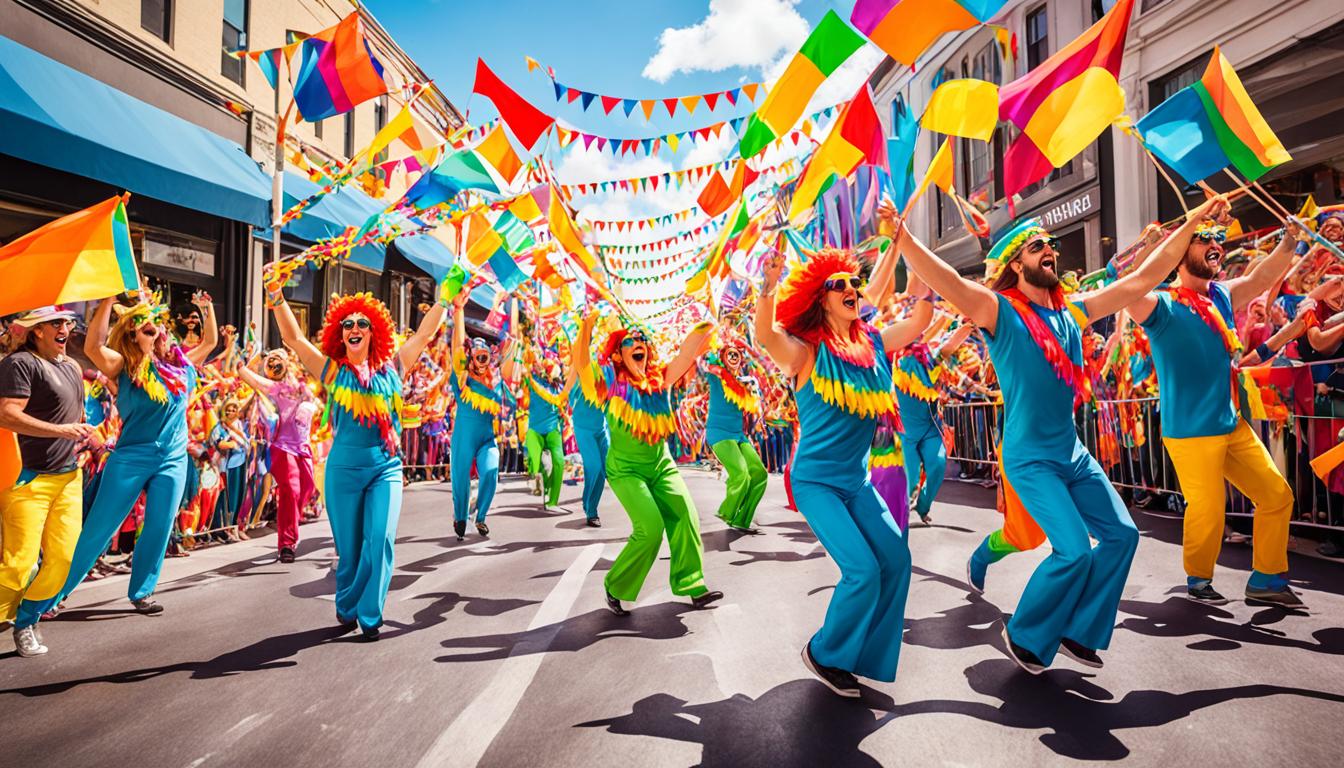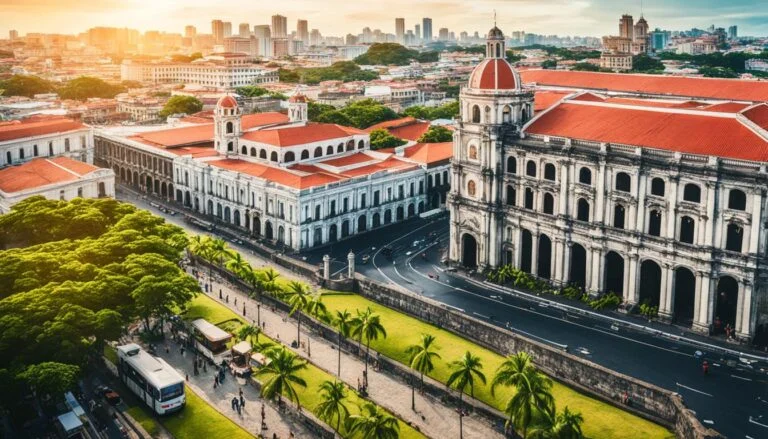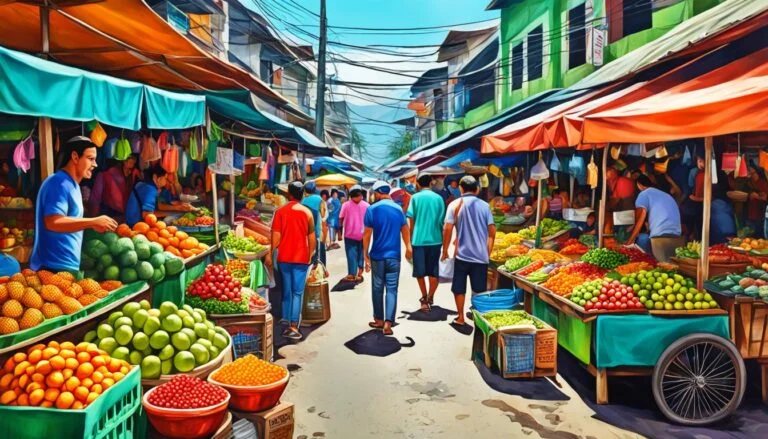5 Must-See Cultural Festivals in the Philippines You Won’t Forget!
Have you ever wondered what it would be like to immerse yourself in the vibrant cultural traditions of the Philippines? From colorful parades to ancient rituals, the country’s captivating festivals offer a glimpse into the heart and soul of this diverse nation. But which ones are truly worth experiencing? Prepare to be enchanted as we uncover the 5 must-see cultural festivals in the Philippines that will leave a lasting impression on your senses.
Key Takeaways
- Discover the Dinagyang Festival in Iloilo City, a celebration that attracts over a million locals and tourists annually1
- Witness the Philippine International Hot Air Balloon Fiesta in Pampanga, featuring over 300 balloon pilots from around the world12
- Immerse yourself in the vibrant Pahiyas Festival in Lucban, Quezon, where homes are decorated with fresh produce and unique decorations1
- Explore the Flores de Mayo celebrations in May, honoring the Virgin Mary through street processions1
- Experience the diverse range of activities, from hot air balloon flying to traditional dances, that characterize these captivating cultural festivals2
Vibrant Celebrations in the Pearl of the Orient
The Philippines is renowned for its vibrant and diverse cultural festivals that take place throughout the year. These celebrations offer a unique opportunity for visitors to immerse themselves in the country’s rich heritage and traditions3. From colorful parades and lively street parties to ancient rituals and traditional performances, the Philippines’ cultural festivals are a feast for the senses4. With over 42,000 major and minor festivals across its 7,641 islands, the Philippines is a true cultural mosaic, showcasing the diversity and resilience of its people.
Locals and tourists alike come together to honor their cultural roots, celebrate the country’s diverse communities, and experience the warm hospitality that the Philippines is famous for5. More than 1.4 million tourists visited the Philippine archipelago during the pre-pandemic period, drawn by the country’s vibrant cultural celebrations. These festivals not only preserve age-old traditions but also provide a platform for locals to showcase their creativity, artistry, and community pride.
From the iconic Sinulog Festival in Cebu, celebrated annually on January 15th3, to the MassKara Festival in Bacolod City, held every October 4th3, the Philippines offers a diverse array of cultural festivals that cater to the interests of both local and international visitors5. The MassKara Festival, for instance, draws around 3 million annual attendees and lasts for 20 days, showcasing the resilience and joyful spirit of the Bacolodnons.
Whether you’re drawn to the colorful Pahiyas Festival in Lucban, Quezon, celebrated on May 15th3, or the captivating Philippine International Hot Air Balloon Fiesta in Clark, Pampanga, held for four days between January and February5, the Philippines’ cultural celebrations are a true feast for the senses, offering visitors a glimpse into the country’s rich tapestry of traditions and customs.
Sinulog Festival: The Queen of Philippine Festivities

The Sinulog Festival, held every third Sunday of January in Cebu City, is one of the most iconic cultural festivals in the Philippines6. This vibrant celebration honors the Santo Niño (Holy Child Jesus) and features a grand parade with colorful costumes, intricate floats, and energetic street dancing6. Thousands of locals and tourists flock to Cebu to witness the festival’s vibrant displays, with participants representing various communities and cultural groups7.
The Sinulog Festival attracts between 1 million and 1.5 million people each year, making it the biggest festival in the Philippines6. The first Sinulog parade was organized on January 20, 1980, making the festival 44 years old as of 20236. The festival involves students dressed in Knitted Filipiniana costumes who dance to the beating of drums, commemorating the Filipino people’s acceptance of Christianity and their rejection of their former animist beliefs6.
The Sinulog Festival in Cebu attracts between 1 to 2 million visitors annually from all over the country7. The Grand Street Parade during the festival starts on the third Sunday of January at around 8 or 9 in the morning7. Cebu City is known for its history, offering tourists a variety of historical tours, sightseeing tours, and pilgrimage tours7. Thousands of devotees join the fluvial parade during the Sinulog Festival, starting around 6 in the morning7.
The Sinulog Festival has been a tradition for 32 years, and over the years, it has evolved into a month-long celebration8. The festival includes various contests such as art exhibits, beauty pageants, and photo contests8. The festival has been recognized as the “City of Culture” by the Association of Southeast Asian Nations (ASEAN)867.
Philippine International Hot Air Balloon Fiesta

The Philippine International Hot Air Balloon Fiesta, held annually in the second week of February in Pampanga, is a must-see spectacle that captivates visitors from around the world9. This long-running festival, which was founded in 1994 and has been active from 1994 to 1998 and then from 2000 to 20199, features an array of thrilling activities, including hot air balloon launches, helicopter exhibitions, freestyle aerobatics, flag jumps, choreographed kite flying, and even skydiving9.
The main attraction of the festival is the stunning sight of dozens of colorful hot air balloons taking to the sky, creating a breathtaking display that leaves all who witness it in awe9. Over the years, the festival has attracted an average attendance of approximately 1, subject to higher variations9, with a peak attendance of around 60,000 visitors in 20069. In 2017, the festival hosted 30 hot air balloons and welcomed participants from various countries, including the United States, Canada, and Japan9, while the 2024 edition is set to feature 18 hot air balloons, each reaching up to 30 meters in size and soaring as high as 12,000 feet9.
Beyond the hot air balloons, the festival offers a diverse range of programs, including skydiving, flag jumps, aerobatics, precision maneuvers, and kite-flying exhibitions, catering to the interests of aviation enthusiasts and outdoor adventurers alike9. Visitors can choose from a variety of ticket options, including economy, business, and first-class packages, to enjoy the festivities from the best vantage points10.
The Philippine International Hot Air Balloon Fiesta has been running for 24 years, making it Asia’s longest-running air festival11. The event, which was previously held in Tarlac province, has now found a new home at the New Clark City complex in Capas, Tarlac, offering a larger space and a stadium capable of accommodating up to 20,000 people11. The 24th edition of the festival is scheduled to take place from February 16 to 18, 202410, and will feature a diverse range of air sports activities, as well as ground-level entertainment and amenities to cater to the diverse interests of attendees11910.
Philippines cultural festivals: A Feast for the Senses

The Philippines’ cultural festivals are a true feast for the senses, offering visitors an immersive and unforgettable experience. These celebrations showcase the country’s rich heritage, diverse communities, and vibrant traditions through a dazzling array of sights, sounds, and flavors12. From the vibrant street parades and intricate costumes to the captivating music and dance performances, and the mouthwatering local cuisine, each festival provides a unique window into the heart and soul of the Philippines.
One of the most celebrated religious and cultural events in the country is the Sinulog Festival, held annually on the third Sunday of January in Cebu City12. Visitors can expect to be captivated by the vibrant street parades, intricate costumes, and lively dance performances that pay homage to the Santo Niño (Holy Child Jesus)13. The Panagbenga Festival, known as the “Flower Festival,” is held in Baguio City in February, celebrating the blooming of flowers and the region’s rich cultural heritage12.
The Kadayawan Festival, celebrated in August in Davao City, showcases the region’s bountiful agricultural harvest and cultural traditions through a kaleidoscope of colors, sounds, and flavors12. Visitors can immerse themselves in the lively street dances, vibrant costumes, and the mouthwatering local cuisine that reflect the essence of Filipino culture13.
Another must-see festival is the Pahiyas Festival in Quezon, which occurs every May to celebrate the bountiful harvest season12. The festival is characterized by vibrant decorations made from rice, fruits, vegetables, and other agricultural products, creating a visually stunning spectacle that reflects the creativity and resourcefulness of the local community14.
The Ati-Atihan Festival, considered the “Mother of All Philippine Festivals,” is held in Kalibo, Aklan, during the third week of January, fusing religious devotion and cultural merriment12. This ancient festival, with its roots tracing back centuries, is a testament to the rich cultural heritage and community spirit of the Philippines141213.
Pahiyas Festival: A Kaleidoscope of Colors

The Pahiyas Festival, held annually on May 15th in Lucban, Quezon, is a vibrant celebration that honors the Patron Saint of Farmers, San Isidro de Labrador15. This colorful festival showcases the ingenuity and agricultural abundance of the region, with locals decorating their homes in a dazzling array of fresh produce, fruits, vegetables, and intricate leaf-shaped wafers called “Kipings.”15 The streets come alive with a kaleidoscope of colors, as the town’s residents compete to create the most elaborate and visually stunning displays15.
Visitors can stroll through the streets, admire the decorations, and sample the delicious local cuisine, all while immersing themselves in the joyous spirit of this celebration of the land and its bounty16. The Pahiyas Festival originated in May 196316, and has since become a cherished tradition, attracting thousands of people from all over the Philippines and the world15.
The festival’s vibrant displays are not just for show – they reflect the deep connection between the people of Lucban and their agricultural heritage16. Locals decorate their homes with a variety of colorful fruits, vegetables, and the signature *Kipings*, intricate rice wafers that are painstakingly crafted and adorned with dazzling hues16. The result is a breathtaking visual feast that celebrates the region’s bountiful harvests and the hard work of its farmers15.
Beyond the stunning decorations, the Pahiyas Festival is also a time for the community to come together and enjoy traditional Filipino music, dance, and cuisine15. Visitors can indulge in the local delicacies, such as the renowned *Lucban Longganisa*, a garlicky pork sausage that is a specialty of the region16. The festival’s vibrant atmosphere and warm hospitality make it a truly unforgettable experience for all who attend151716.
Conclusion: Embrace the Spirit of Filipino Hospitality
The captivating cultural festivals of the Philippines offer a remarkable opportunity for travelers to immerse themselves in the country’s vibrant heritage and traditions18. From the grand parades and lively street parties to the enchanting performances and mouthwatering local cuisine, these celebrations are a true feast for the senses19. Whether attending the iconic Sinulog Festival, the colorful Pahiyas Festival, or any of the other renowned celebrations across the archipelago, visitors are greeted with a warm welcome and a glimpse into the deep-rooted hospitality and community spirit that are integral to the Filipino way of life20.
By embracing the spirit of these cultural festivals, travelers can gain a deeper appreciation for the Philippines’ diverse cultural tapestry and create lasting memories of their time in this remarkable country19. The country’s18 population of over 116 million, its rich tradition of18 indigenous arts and architecture, and the20 enduring spirit of bayanihan, or community cooperation, all contribute to the country’s vibrant cultural landscape1820.
As visitors immerse themselves in the Philippines’19 diverse natural wonders and19 UNESCO-recognized heritage sites, they are sure to be captivated by the warmth and hospitality of the Filipino people, leaving with a newfound appreciation for the country’s exceptional cultural heritage19. By embracing the spirit of these festivals, travelers can forge meaningful connections and leave with a deeper understanding of the Philippines’ vibrant and resilient spirit20.







